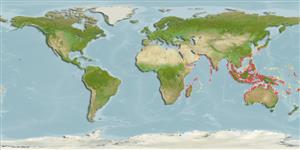Actinopterygii (ray-finned fishes) >
Perciformes (Perch-likes) >
Gobiidae (Gobies) > Gobiinae
Etymology: Bathygobius: Greek, bathys = deep + Latin, gobius = gudgeon (Ref. 45335).
Environment / Climate / Range
Ecology
Marine; brackish; demersal. Tropical, preferred ?
Indo-West Pacific.
Size / Weight / Age
Maturity: Lm ? range ? - ? cm
Max length : 6.0 cm TL male/unsexed; (Ref. 11441)
Dorsal
spines
(total): 7;
Dorsal
soft rays
(total): 9;
Anal
spines: 1;
Anal
soft rays: 8. Characterized by male with yellowish grey color, densely and diffusely mottled with dusky, bluish whit and dull orange spots; female with dark grey brown color dorsally, paler ventrally, with five large yellowish white blotches dorsally from nape to caudal peduncle; broadly yellow outer part of first dorsal fin in both sexes; upper 5-6 pectoral rays free of membrane; rounded caudal fin; longitudinal scale series 34-40; predorsal scales 14-19, reaching to within half eye diameter of rear edge of eye; cheek and opercle without scales; ctenoid body scales, becoming cycloid on anterior body; depressed head, width greater than depth; depth of body 4.1-4.3 in SL (Ref. 90102).
Inhabits rocky pools of intertidal zone and rocky shores (Ref. 90102). Specimens collected from tide pools of exposed coasts (Ref. 11441).
Life cycle and mating behavior
Maturity | Reproduction | Spawning | Eggs | Fecundity | Larvae
Randall, J.E., 1995. Coastal fishes of Oman. University of Hawaii Press, Honolulu, Hawaii. 439 p. (Ref. 11441)
IUCN Red List Status (Ref. 115185)
CITES (Ref. 94142)
Not Evaluated
Threat to humans
Harmless
Human uses
More information
Common namesSynonymsMetabolismPredatorsEcotoxicologyReproductionMaturitySpawningFecundityEggsEgg development
ReferencesAquacultureAquaculture profileStrainsGeneticsAllele frequenciesHeritabilityDiseasesProcessingMass conversion
Tools
Special reports
Download XML
Internet sources
Estimates of some properties based on models
Phylogenetic diversity index (Ref.
82805): PD
50 = 0.5000 [Uniqueness, from 0.5 = low to 2.0 = high].
Bayesian length-weight: a=0.00631 (0.00286 - 0.01390), b=3.08 (2.90 - 3.26), in cm Total Length, based on LWR estimates for this (Sub)family-body shape (Ref.
93245).
Trophic Level (Ref.
69278): 3.3 ±0.5 se; Based on size and trophs of closest relatives
Resilience (Ref.
69278): High, minimum population doubling time less than 15 months (Preliminary K or Fecundity.).
Vulnerability (Ref.
59153): Low vulnerability (13 of 100) .
